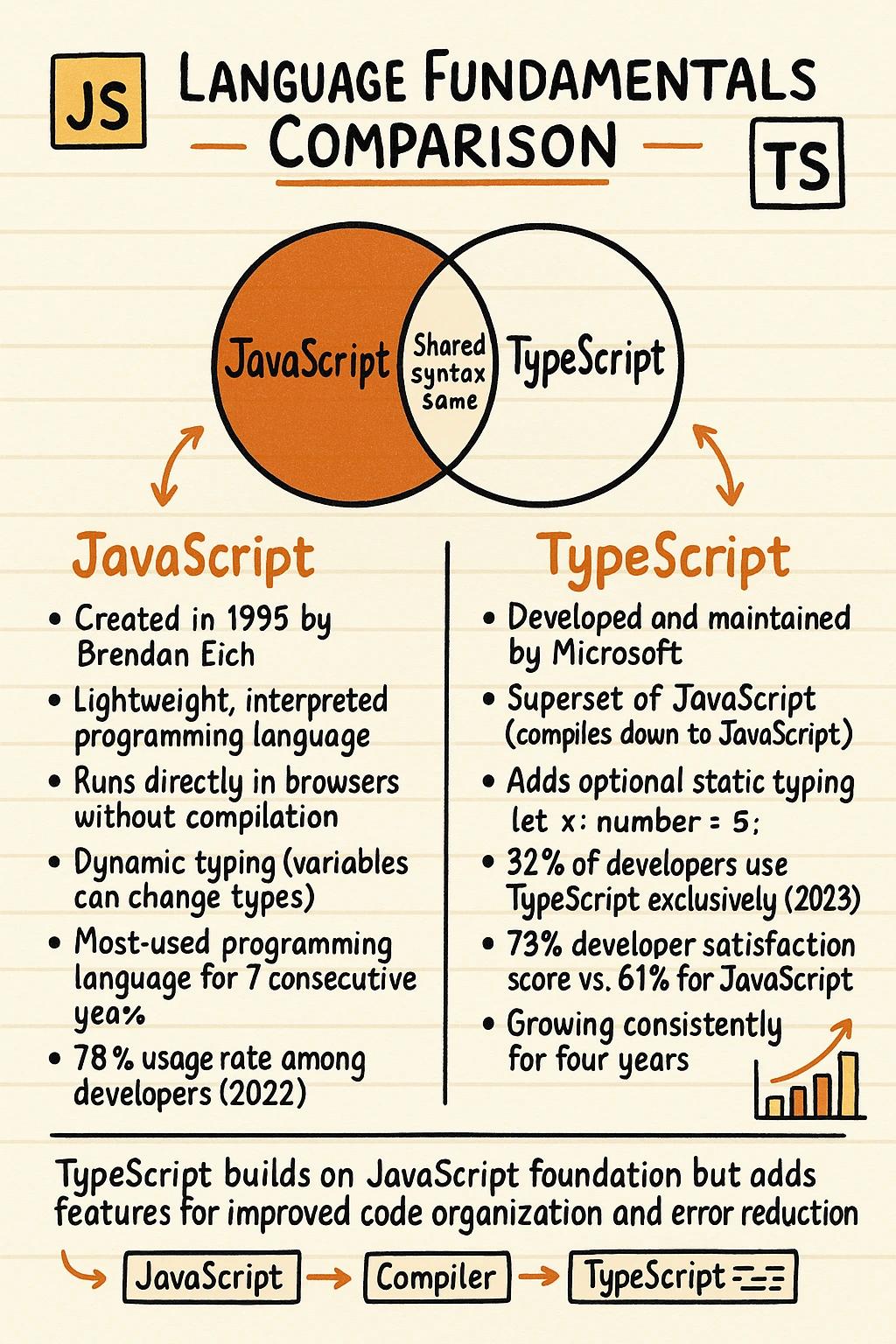TypeScript vs JavaScript

Choosing the right programming language can make or break your web development project. JavaScript has long been the backbone of web development, but TypeScript has gained significant traction in recent years. This guide will help you understand the key differences between these languages and make an informed decision for your next project.
Both languages have their strengths and ideal use cases. Your choice should align with your project requirements, team expertise, and long-term maintenance goals. Let's examine what makes each language unique and when you should use one over the other.
What is JavaScript?
JavaScript is a lightweight, interpreted programming language that allows you to create interactive elements on websites. Created in 1995 by Brendan Eich, it has evolved into one of the most versatile programming languages in the world.
As a dynamic language, JavaScript offers flexibility in how you write and structure code. It runs directly in web browsers without compilation. This direct execution makes it quick to test changes and iterate on your code.
JavaScript remains the most-used programming language for seven consecutive years, demonstrating its enduring relevance in web development. (Source: JetBrains)
Here are the key features that have contributed to JavaScript's widespread adoption:
- Dynamic typing - Variables can change types during execution
- First-class functions - Functions can be assigned to variables
- Prototype-based inheritance - Objects inherit directly from other objects
- Event-driven programming - Code responds to user actions
JavaScript powers everything from simple websites to complex web applications. Its versatility extends beyond browsers with Node.js, enabling server-side development with the same language.
What is TypeScript?
TypeScript is a strongly-typed superset of JavaScript developed and maintained by Microsoft. It adds optional static typing and other features that help catch errors early in the development process.
At its core, TypeScript compiles down to plain JavaScript. This means anything you can write in JavaScript can also be written in TypeScript. However, TypeScript adds powerful features that help manage complexity in larger codebases.
The adoption of TypeScript has grown significantly, with 32% of developers using TypeScript exclusively as of 2023. (Source: Socket)
TypeScript offers several features that extend JavaScript's capabilities:
- Static typing - Declare variable types for better error checking
- Interfaces - Define clear contracts for how objects should be structured
- Generics - Create reusable components that work with various data types
- Advanced IDE support - Better code completion and error detection
While TypeScript requires a compilation step, modern build tools make this process nearly seamless. The extra step pays off with better code organization and fewer runtime errors.

Key Differences Between JavaScript and TypeScript
Understanding the fundamental differences between these languages helps clarify when to use each one. Both have specific strengths that apply to different project types and team compositions.
The following table provides a side-by-side comparison of the key aspects of both languages:
Type System:
- JavaScript: Dynamic (loose) typing
- TypeScript: Static (strict) typing with optional type annotations
Compilation:
- JavaScript: Interpreted directly
- TypeScript: Compiled to JavaScript
Error Detection:
- JavaScript: Runtime errors
- TypeScript: Compile-time + runtime errors
Learning Curve:
- JavaScript: Lower entry barrier
- TypeScript: Steeper (requires JS knowledge plus TS concepts)
Project Size Suitability:
- JavaScript: Small to medium projects
- TypeScript: Medium to large projects
This comparison highlights how the languages differ in their core behavior and project applicability. Let's explore these differences in greater detail.
Type System
JavaScript uses dynamic typing, where variable types are determined at runtime. This flexibility can speed up initial development but may lead to unexpected errors when variables contain unintended types.
TypeScript introduces static typing, where variable types are defined during development. This approach catches type-related errors before the code runs. The compiler flags issues like trying to use a string method on a number value.
For real estate website development projects, where data structures are often complex and consistent, TypeScript's type system can help maintain data integrity throughout the codebase. This is especially valuable when working with property listings, user profiles, and transaction data.
Development Experience
The development experience differs significantly between the two languages. JavaScript offers a simpler setup with fewer configuration steps. You can write code and run it immediately in a browser or Node.js environment.
TypeScript provides enhanced developer tools and IDE support. The development experience benefits from features like intelligent code completion, interface implementation, and immediate error feedback. According to usage statistics, 51% of developers use Visual Studio Code for JavaScript and TypeScript projects, partly due to its excellent TypeScript integration. (Source: JetBrains)
When working with complex web platforms like Webflow, these developer experience improvements can significantly impact productivity and code quality.
Learning Curve
JavaScript has a lower barrier to entry than TypeScript. Web developers often learn JavaScript first because it's essential for browser-based applications. The language is relatively easy to pick up, with immediate visual feedback in the browser.
TypeScript builds on JavaScript knowledge but adds concepts like interfaces, type declarations, and generics. Developers need to understand both JavaScript and TypeScript-specific features. This steeper learning curve requires more initial investment but pays dividends in code maintenance.
For teams with varying skill levels, this learning curve can impact project timelines and training requirements. Consider your team's current expertise when deciding between these languages.

Project Scale Considerations
JavaScript works well for smaller projects where flexibility and rapid development are priorities. Its dynamic nature lets you iterate quickly without managing type definitions. Simple websites, prototypes, and small applications often benefit from JavaScript's simplicity.
TypeScript shines in larger, more complex applications where multiple developers collaborate. As projects grow, TypeScript's structure helps maintain consistency and prevents common errors. Enterprise applications, complex web platforms, and long-lived codebases typically benefit from TypeScript's added safeguards.
The decision often depends on your project's expected lifespan and complexity. Short-term projects might benefit from JavaScript's simplicity, while long-term projects generally see returns on the TypeScript investment.
Performance Comparison
When evaluating programming languages, performance considerations play a crucial role in the decision-making process. Both JavaScript and TypeScript have different performance characteristics at various stages of the development lifecycle.
The following table breaks down performance aspects across different dimensions:
Development Speed:
- JavaScript: Faster initial development
- TypeScript: Slower initial development, faster later phases
Build Time:
- JavaScript: No compilation needed
- TypeScript: Requires compilation (adds build time)
Runtime Performance:
- JavaScript: Equivalent (after TS compilation)
- TypeScript: Equivalent (compiles to JS)
Debugging Experience:
- JavaScript: More runtime debugging needed
- TypeScript: Fewer runtime bugs, easier to debug
Refactoring Speed:
- JavaScript: Slower, higher risk
- TypeScript: Faster, lower risk
It's important to understand that TypeScript code compiles to JavaScript, so the runtime performance is virtually identical. The performance differences primarily affect the development process rather than the end user experience.
During initial development, JavaScript projects can progress more quickly without type definitions and compilation steps. This advantage diminishes as projects grow in size and complexity.
For maintenance and refactoring, TypeScript offers significant performance advantages. Type checking helps prevent breaking changes and highlights affected code during updates. This difference becomes more pronounced in larger codebases with frequent changes.
When to Choose JavaScript for Your Project
JavaScript remains an excellent choice for many project types. Its simplicity and flexibility offer advantages in specific scenarios. Consider JavaScript when your project fits these conditions:
- Small to medium-sized projects with limited complexity
- Rapid prototyping where speed of development is critical
- Small team or solo development with consistent coding patterns
- Short-term projects without extensive maintenance requirements
- When team members have limited TypeScript experience and training time is constrained
JavaScript excels in scenarios where you need to move quickly and iterate rapidly. For real estate companies launching simple marketing websites or single-purpose tools, JavaScript often provides the fastest path to deployment.
Another consideration is your integration requirements. If you're working with existing systems that use JavaScript-based integrations, maintaining consistency might be easier with JavaScript.
JavaScript's widespread usage means finding developers is generally easier. With a 78% usage rate among developers as of 2022, JavaScript skills are abundant in the job market. (Source: RadixWeb)
When to Choose TypeScript for Your Project
TypeScript offers compelling advantages for certain project types and team compositions. Its structured approach shines in more complex development scenarios. Consider TypeScript when your project matches these criteria:
- Medium to large-scale applications with significant complexity
- Long-lived codebases requiring ongoing maintenance
- Team environments with multiple developers working together
- Projects with complex data models that benefit from interface definitions
- When reducing runtime errors is a critical priority
TypeScript delivers substantial benefits for ongoing maintenance. Projects migrated to TypeScript show 40% long-term maintenance cost reductions by preventing common errors and improving code predictability. (Source: Index.dev)
Developer satisfaction tends to be higher with TypeScript. According to the 2023 Stack Overflow Survey, TypeScript has a 73% developer satisfaction score compared to 61% for JavaScript. (Source: Index.dev)
For real estate development companies building complex property management systems or interactive visualization tools like those offered by Dignuz Design, TypeScript provides valuable safeguards. These applications often involve complex data relationships that benefit from TypeScript's type checking and interface definitions.

Migration Strategies: From JavaScript to TypeScript
Many projects start with JavaScript and later transition to TypeScript as complexity increases. This migration can happen gradually, allowing teams to adopt TypeScript at their own pace. A phased approach minimizes disruption while capturing TypeScript's benefits.
Here's a proven strategy for migrating from JavaScript to TypeScript:
- Set up the TypeScript environment alongside existing JavaScript
- Configure allowJs in tsconfig.json to allow mixed JavaScript and TypeScript
- Convert files incrementally, starting with simpler, more isolated modules
- Begin with loose type checking and gradually increase strictness
- Add type definitions for external libraries using DefinitelyTyped or package typings
The key to successful migration is patience. The process works best when spread over time, with each component carefully converted and tested. This approach allows teams to learn TypeScript while continuing to deliver features.
For established real estate websites built with JavaScript, gradual migration to TypeScript can improve maintainability without requiring a complete rewrite. This approach is especially valuable for sites with frequent updates to property listings or user interfaces.
Preparation:
- Activities: Set up build tools, establish TypeScript config
- Benefits: Minimal disruption to existing work
Initial Conversion:
- Activities: Convert simple files, use "any" type where needed
- Benefits: Quick wins, team familiarization
Progressive Typing:
- Activities: Replace "any" with specific types, add interfaces
- Benefits: Improved type safety in converted areas
Strictness Increase:
- Activities: Enable stricter compiler options gradually
- Benefits: Catch more potential issues
Complete Migration:
- Activities: Convert all files, remove allowJs if desired
- Benefits: Full TypeScript benefits across codebase
This phased approach allows teams to distribute the migration effort over time while continuing to deliver business value. Each phase builds on the previous ones, gradually increasing type safety and code quality.
Real-World Adoption and Trends
The popularity and adoption patterns of both languages provide valuable context for making an informed decision. Industry trends often indicate which technology might have better long-term support and ecosystem growth.
Current statistics show that while JavaScript remains dominant, TypeScript continues to gain market share. TypeScript adoption has grown consistently for four years, indicating strong industry acceptance. (Source: TSH)
In 2023, 20.7% of developers reported using only TypeScript, showing significant adoption beyond just occasional use. (Source: TSH)
The following table shows the adoption patterns across different industry segments:
Startups:
- JavaScript Prevalence: High
- TypeScript Prevalence: Medium and growing
- Notable Trend: Increasing TypeScript adoption as products mature
Enterprise:
- JavaScript Prevalence: Medium
- TypeScript Prevalence: High and growing
- Notable Trend: Strong preference for TypeScript's safety features
Agencies:
- JavaScript Prevalence: High
- TypeScript Prevalence: Medium
- Notable Trend: Project-specific choices based on client needs
Open Source:
- JavaScript Prevalence: High
- TypeScript Prevalence: Medium and growing
- Notable Trend: Major frameworks offering TypeScript support
Looking forward, enterprise adoption of TypeScript is projected to reach 80% by 2025 as larger organizations prioritize code maintainability and error reduction. (Source: Index.dev)
This trend suggests that TypeScript skills will become increasingly valuable for developers working on enterprise-level applications. For web development agencies like Dignuz Design, familiarity with both languages provides the flexibility to meet various client needs.
Making the Final Decision
Choosing between JavaScript and TypeScript requires weighing various factors specific to your project and team. The right choice varies based on your unique circumstances rather than universal rules.
Consider these key factors when making your decision:
Project Size:
- Choose JavaScript If...: Small to medium website or application
- Choose TypeScript If...: Large application with many components
Team Experience:
- Choose JavaScript If...: Team has strong JavaScript but limited TypeScript experience
- Choose TypeScript If...: Team has TypeScript experience or time to learn
Project Timeline:
- Choose JavaScript If...: Tight deadline with focus on quick delivery
- Choose TypeScript If...: Longer timeline with focus on quality and maintenance
Maintenance Needs:
- Choose JavaScript If...: Short lifespan or minimal future changes expected
- Choose TypeScript If...: Long lifespan with ongoing updates and maintenance
Team Size:
- Choose JavaScript If...: Small team with good communication
- Choose TypeScript If...: Larger team needing structural guidance
For real estate web projects, the decision often hinges on the project's complexity and long-term goals. A simple property listing page might be perfectly served by JavaScript, while a comprehensive property management system would benefit from TypeScript's structured approach.
At Dignuz Design, we evaluate each client's specific needs when recommending a technology approach. Our expertise with both JavaScript and modern web development platforms allows us to make recommendations based on project requirements rather than personal preferences.
Remember that you can start with JavaScript and migrate to TypeScript later if needed. This flexibility allows you to begin development quickly while keeping the option to add type safety as your project evolves.
Conclusion
Both JavaScript and TypeScript have their place in modern web development. JavaScript offers simplicity, flexibility, and a lower learning curve, making it ideal for smaller projects and rapid development. TypeScript provides structure, safety, and improved maintainability, making it valuable for larger, long-term projects.
Your choice should align with your specific project requirements, team composition, and long-term goals. Consider factors like project size, team experience, timeline, and maintenance needs when deciding which language to use.
The trends show TypeScript gaining momentum, particularly in enterprise environments and larger applications. However, JavaScript continues to be the foundation of web development and remains an excellent choice for many scenarios.
For real estate companies looking to develop their online presence, the choice between JavaScript and TypeScript should be part of a broader technology strategy that considers both immediate needs and future growth. Working with experienced developers who understand both languages ensures you get the right solution for your specific situation.
If you're still uncertain about which language is right for your next web development project, consider consulting with experts who can evaluate your specific needs and provide tailored recommendations based on your unique requirements.



